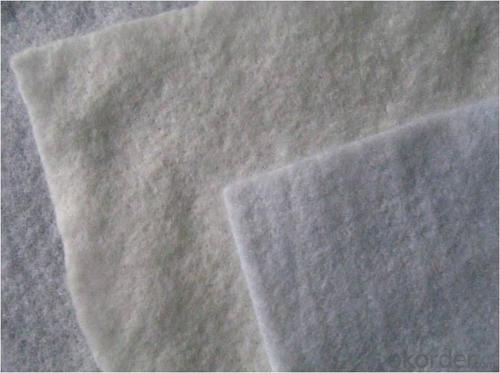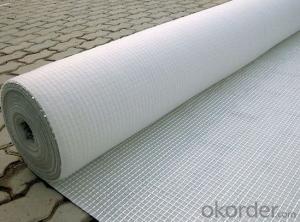500g Nonwoven Geotextile for Real Estate - Geotextile KSA
- Loading Port:
- China main port
- Payment Terms:
- TT OR LC
- Min Order Qty:
- 3000 m²
- Supply Capability:
- 1000000 m²/month
OKorder Service Pledge
OKorder Financial Service
You Might Also Like
Specification
Continuous Filament Nonwoven Geotextile Composition & Feature
a new construction material, the raw material of which is polypropylene(PP) fiber, without chemical additives and heat treatment.
Environment friendly construction material.
Unit Weight of Continuous Filament Nonwoven Geotextile
100g/m2, 150g/m2, 200g/m2, 250g/m2, 300g/m2, 350g/m2, 400g/m2, 450g/m2, 500g/m2, 600g/m2, 800g/m2 or customerized
Tensile strength comparation between short filament geotextile and Continuous filament geotextile
The tensile strength of filament geotextile is higher than short filament geotextile.
Characteristic of Geotextile
Superior water permeability, filtrability and deformation adaptive faculty
Resist to corrosion and also anti-aging
Geotextile has high water diversion property, it can form drainage passageway, transpire the surplus liquid and gas
High water permeability even under the pressure of soil and water
Spread, transfer or decompose the concentrate stress effectively to avoid the soil be damaged by outside affection
To prevent the freestone upper and lower level, soil and concrete mixed
Polypropylene fiber or polyester fiber and other chemical fiber as raw material, acid-alkali-proof, corrosion resisting, non warm-eaten,antioxidant
Light, convenient to use, easy construction, shorten working-period, increase economic efficiency
Make use of geotextile to strengthen the tensile strength and anti-deformation property of soil, increase the stability of building structure, and also improve the soil quality
Application of Geotextile
Support many civil engineering applications including:
--Roads
--Airfields
--Railroads
--Embankments
--Retaining structures
--Reservoirs
--Canals
--Dams
--Bank protection
--Coastal engineering
--Construction site silt fences or geotube

Packaging & Shipping
Packing: PLASTIC FILM INSIDE, AND WOVEN BAG OUTSIDE
Shipping: About 15 days after receipt the deposit
geotextile fabric
permeability,filtration,easy for construction
ISO and CE certificate
Good quality and competitive price
Our Service
Quality assurance
1.On a regular basis or as per your request,we entrust national testing agencies to conduct quality inspections
2. Strictly in accordance with the ISO9001-2008 international quality system standard,we monitor and manage the whole process throughout production,quality testing,and measurement to ensure product quality
3. For quality-related construction delay or substandard construction(except for damage or losses due to customer’s responsibility or irresistible natural disasters),we have refunding,replacement,and repair services.We will respond to customers’ feedbacks on quality issues within 24 hours.
After-sales service
1.In order to provide customers with comprehensive technical support,we will provide technical and other related information upon request in a timely manner.
2.In required,we will appoint specialized technicians to the construction site to give technical trainings to construction people,and offer technical guidance throughout the whole construction process.
3.For damage due to shipment and delivery,after we receive the complaint,we will check the issure through provided pictures and videos.If our responsibility is confirmed,we wil offer free replacement.
4.When the construction is completed,as your request,our technical staff may participate in the final acceptance.
FAQ:
Q: What kind of payments does jenor support?
A: T/T, L/C, Cash are accepted.
Q: Do you charge for the samples?
A: Accordeing to our company policy, the samples are free, we only charge the freight fee. And we will return the freight fee during the next order.
Q: Can you produce according to customers' design?
A: Sure, we are professional manufacturer, OEM and ODM are both welcome.
Q: Do you have other products?
A: Yes, please check the pictures:
- Q: How do geotextiles help in filtration?
- Geotextiles help in filtration by acting as a physical barrier that allows water to pass through while filtering out fine particles and contaminants. They prevent the clogging of the filtration system, improve water quality, and enhance overall filtration efficiency.
- Q: Can geotextiles be used in landscaping?
- Yes, geotextiles can be used in landscaping. Geotextiles are commonly used in landscaping projects as a way to control erosion, stabilize soil, and prevent weed growth. They are particularly useful in areas where there is heavy rainfall or sloping terrain, as they help to retain soil and prevent erosion. Additionally, geotextiles can be used to separate different layers of soil, provide drainage, and reinforce structures such as retaining walls.
- Q: How do geotextiles help with soil reinforcement in mechanically stabilized earth walls?
- Geotextiles help with soil reinforcement in mechanically stabilized earth walls by providing a strong and stable base for the soil. They distribute the load evenly, reducing the risk of soil erosion and increasing the wall's stability. Additionally, geotextiles improve the soil's drainage capabilities, preventing water buildup and further enhancing the wall's structural integrity.
- Q: How do geotextiles contribute to groundwater recharge?
- Geotextiles can contribute to groundwater recharge by acting as a filtration system, allowing water to pass through while preventing the movement of soil particles. This helps to prevent the clogging of recharge basins or infiltration trenches, ensuring a more efficient recharge of groundwater.
- Q: How are geotextiles used in landfills?
- Geotextiles are used in landfills to help enhance the stability, drainage, and filtration of the waste disposal site. They are typically placed between the layers of soil and the landfill liner system to prevent soil erosion, control gas and liquid migration, and provide reinforcement for the overall structure.
- Q: What is the lifespan of geotextiles?
- The lifespan of geotextiles can vary depending on various factors such as the quality of the material, the environmental conditions, and the specific application. Generally, geotextiles are designed to have a durable and long-lasting lifespan ranging from 10 to 50 years. Regular maintenance and proper installation can also contribute to extending their lifespan.
- Q: Does geotextile affect water purification?
- Do not know what you use after the purification of water, if not drinking water, I think it will not affect the water quality, the general purpose of water purification, geotextile will not affect, because the geotextile material is polyester or polypropylene, In the chemical nature of relatively stable, no changes in room temperature conditions, so there will not be any impact on water quality
- Q: Can geotextiles be used for filtration purposes?
- Yes, geotextiles can be used for filtration purposes. They are designed to allow water or other liquids to pass through while retaining soil or other particles, making them effective for various filtration applications in areas such as agriculture, construction, and environmental engineering.
- Q: Composite geotextile per square meter of labor costs how much money 'sewage treatment pool' ground plane 'square meters. More
- The cost of 2-5 yuan ranging from the specific needs to see you as well as construction machinery personnel
- Q: Geotextile use
- Geotextile is a new type of building materials, raw materials are polyester, acrylic, nylon and other polymer polymer synthetic fiber. In accordance with the manufacturing method is divided into: there are two types of geotextile and non-woven geotextile. Geotextile with anti-seepage, anti-filtration, drainage, isolation, reinforcement, protection, sealing and other functions, it with the conventional masonry and concrete material seepage effect compared to a low investment, simple construction process, short duration Infiltration effect is good, the channel effective use of high coefficient. Water conservancy engineering dams and slope protection filter, channel isolation, seepage control; road, railway, airport runway foundation isolation, filter, drainage, slope, retaining wall and road reinforcement, drainage; , Geotextile has been widely used in the field of infrastructure construction, and has been gradually applied in the field of infrastructure construction, and the use of geotextile In a wider area.
Send your message to us
500g Nonwoven Geotextile for Real Estate - Geotextile KSA
- Loading Port:
- China main port
- Payment Terms:
- TT OR LC
- Min Order Qty:
- 3000 m²
- Supply Capability:
- 1000000 m²/month
OKorder Service Pledge
OKorder Financial Service
Similar products
Hot products
Hot Searches
Related keywords




























